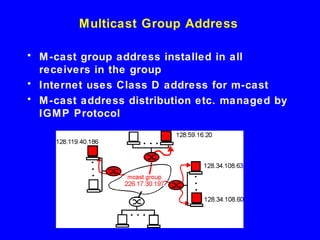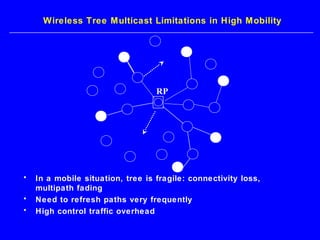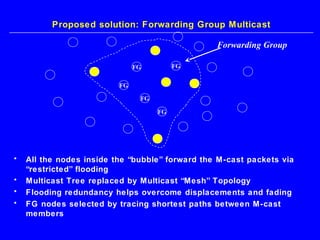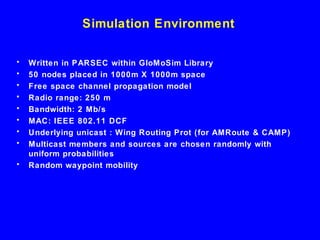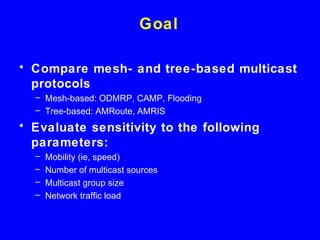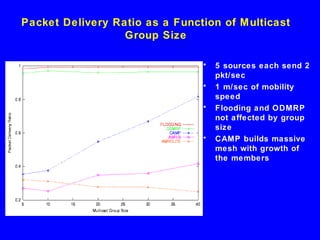Multicast in computer Architecture
- 1. Multicast ad hoc networks • • • • • • Review of M ulticasting in wired networks Tree based wireless multicast M esh based wireless multicast – ODMRP Performance comparison Reliable, congestion controlled multicast Scalable multicast, M-LANM AR
- 2. Multicast Routing • M ulticast: delivery of same packet to a group of receivers • M ulticasting is becoming increasingly popular in the Internet (video on demand; whiteboard; interactive games) • M ultiple unicast vs multicast
- 3. Multicast Group Address • M -cast group address installed in all receivers in the group • Internet uses Class D address for m-cast • M -cast address distribution etc. managed by IGMP Protocol
- 4. The Multicast Tree problem • Problem: find the best (e.g., min cost) tree which interconnects all the members
- 5. Multicast Tree options • GROUP SHARED TREE: single tree; the root (node C below) is the “CORE” or the “Rendez Vous” point; all messages go through the CORE • SOURCE BASED TREE: each source is the root of its own tree connecting to all the members; thus N separate trees
- 6. Group Shared Tree • Predefined CORE for given m-cast group (eg, posted on web page) • New members “join” and “leave” the tree with explicit join and leave control messages • Tree grows as new branches are “grafted” onto the tree • CBT (Core Based Tree) and PIM Sparse-Mode are Internet m-cast protocols based on GSTree • All packets go through the CORE
- 7. Source Based Tree • Each source is the root of its own tree: the tree of shortest paths • Packets delivered on the tree using “reverse path forwarding” (RPF); i.e., a router accepts a packet originated by source S only if such packet is forwarded by the neighbor on the shortest path to S • In other words, m-cast packets are “forwarded” on paths which are the “reverse” of “shortest paths” to S
- 8. Per-Source Tree Multicast Each source supports own separate tree “Probing and Pruning” tree maintenance Reverse Path Forwarding (to avoid endless packet circulation) “Fast Source” problem S2 S1 R2 R1
- 9. RP-based Shared Tree Multicast RP (Rendezvous Point)based “Shared” tree Tree maintenance: soft state “off-center” RP longer paths than shortest path tree RP S1
- 10. Shared Tree vs. Per-source Tree Shared Tree: + + − − scalability less sensitive to fast source longer path off center RP R2 R3 Per-Source Tree: + + + − − shortest path traffic distribution no central node scalability problem fast source problem RP S2 R4 R1 S1
- 11. Wireless Tree Multicast Limitations in High Mobility RP • • • In a mobile situation, tree is fragile: connectivity loss, multipath fading Need to refresh paths very frequently High control traffic overhead
- 12. Proposed solution: Forwarding Group Multicast Forwarding Group FG FG FG FG FG • • • • All the nodes inside the “bubble” forward the M-cast packets via “restricted” flooding Multicast Tree replaced by Multicast “Mesh” Topology Flooding redundancy helps overcome displacements and fading FG nodes selected by tracing shortest paths between M-cast members
- 13. Forwarding Group Concept • • • A set of nodes in charge of forwarding multicast packets Supports shortest paths between any member pairs Flooding helps overcome displacements and channel fading
- 14. ODMRP (On Demand Multicast Routing Protocol) • • • • Forwarding Group Multicast concept Tree replaced by Mesh On-demand approach Soft state
- 15. FG Maintenance (On-Demand Approach) • • • • A sender periodically floods control messages when it has data to send All intermediate nodes set up route to sender (backward pointer) Receivers update Member Tables ; periodically broadcast Join Tables Nodes on path to sources set FG_Flag; FG nodes broadcast Join Tables
- 16. Soft State Approach • No explicit messages required to join/leave multicast group (or FG) • An entry of a receiver’s Member Table expires if no Join Request is received from that sender entry during MEM _TIMEOUT • Nodes in the forwarding group are demoted to non-forwarding nodes if not refreshed (no Join Tables received) within FG_TIMEOUT
- 17. A Performance Comparison Study of Ad Hoc Wireless Multicast Protocols
- 18. Simulation Environment • • • • • • • • • Written in PARSEC within GloMoSim Library 50 nodes placed in 1000m X 1000m space Free space channel propagation model Radio range: 250 m Bandwidth: 2 Mb/s MAC: IEEE 802.11 DCF Underlying unicast : Wing Routing Prot (for AMRoute & CAMP) Multicast members and sources are chosen randomly with uniform probabilities Random waypoint mobility
- 19. Goal • Compare mesh- and tree-based multicast protocols – Mesh-based: ODMRP, CAMP, Flooding – Tree-based: AMRoute, AMRIS • Evaluate sensitivity to the following parameters: – – – – Mobility (ie, speed) Number of multicast sources Multicast group size Network traffic load
- 20. Multicast Protocols • Adhoc Multicast Routing (AMRoute) – Bidirectional shared tree with a core – Relies on unicast protocol to provide routes between multicast members and to handle mobility – Suffers from temporary loops and non-optimal trees
- 21. Multicast Protocols (cont’d) • Ad hoc Multicast Routing protocol utilizing Increasing id-numberS (AMRIS) – Each node is assigned an ID number to build a tree – The increasing id is used in tree maintenance and localized repair – Beacons are sent by each node to neighbors • Core-Assisted Mesh Protocol (CAMP) – A shared mesh for each multicast group – Cores are used to limit the flow of join requests – Relies on certain underlying unicast protocols (e.g., WRP, ALP, etc.)
- 22. Packet Delivery Ratio as a Function of Mobility Speed • • • • 20 members 5 sources each send 2 pkt/sec Mesh protocols outperform tree protocols Multiple routes help overcome fading and node displacements
- 23. Packet Delivery Ratio as a Function of # of Sources • • • • 20 members 1 m/sec of mobility speed Total traffic load of 10 pkt/sec Increasing the number of sender makes mesh richer for ODMRP and CAMP
- 24. Packet Delivery Ratio as a Function of M ulticast Group Size • • • • 5 sources each send 2 pkt/sec 1 m/sec of mobility speed Flooding and ODMRP not affected by group size CAMP builds massive mesh with growth of the members
- 25. Packet Delivery Ratio as a Function of Network Load • • • 20 members and 5 sources no mobility AMRIS is the most sensitive to traffic load due to large beacon transmissions
- 26. Conclusions Tree schemes: Too fragile to mobility lower throughput in heavy load lower control O/H Meshed Based scheme (CAMP): Better than tree schemes (mesh more robust) Mesh requires increasing maintenance with mobility ODMRP: most robust to mobility& lowest O/H Lessons learned: – Mesh-based protocols outperform tree-based protocols – Multiple routes help overcome node displacements and fading



